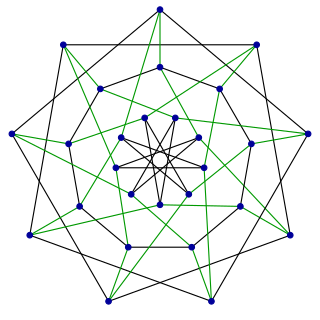Top Qs
Timeline
Chat
Perspective
Holt graph
From Wikipedia, the free encyclopedia
Remove ads
In graph theory, the Holt graph or Doyle graph is the smallest half-transitive graph, that is, the smallest example of a vertex-transitive and edge-transitive graph which is not also symmetric.[1][2] Such graphs are not common.[3] It is named after Peter G. Doyle and Derek F. Holt, who discovered the same graph independently in 1976[4] and 1981[5] respectively.
The Holt graph has diameter 3, radius 3 and girth 5, chromatic number 3, chromatic index 5 and is Hamiltonian with 98,472 distinct Hamiltonian cycles.[6] It is also a 4-vertex-connected and a 4-edge-connected graph. It has book thickness 3 and queue number 3.[7]
It has an automorphism group of order 54.[6] This is a smaller group than a symmetric graph with the same number of vertices and edges would have. The graph drawing on the right highlights this, in that it lacks reflectional symmetry.
The characteristic polynomial of the Holt graph is
Remove ads
Gallery
- The chromatic number of the Holt graph is 3.
- The chromatic index of the Holt graph is 5.
- The Holt graph is Hamiltonian.
- The Holt graph is a unit distance graph.
References
Wikiwand - on
Seamless Wikipedia browsing. On steroids.
Remove ads






